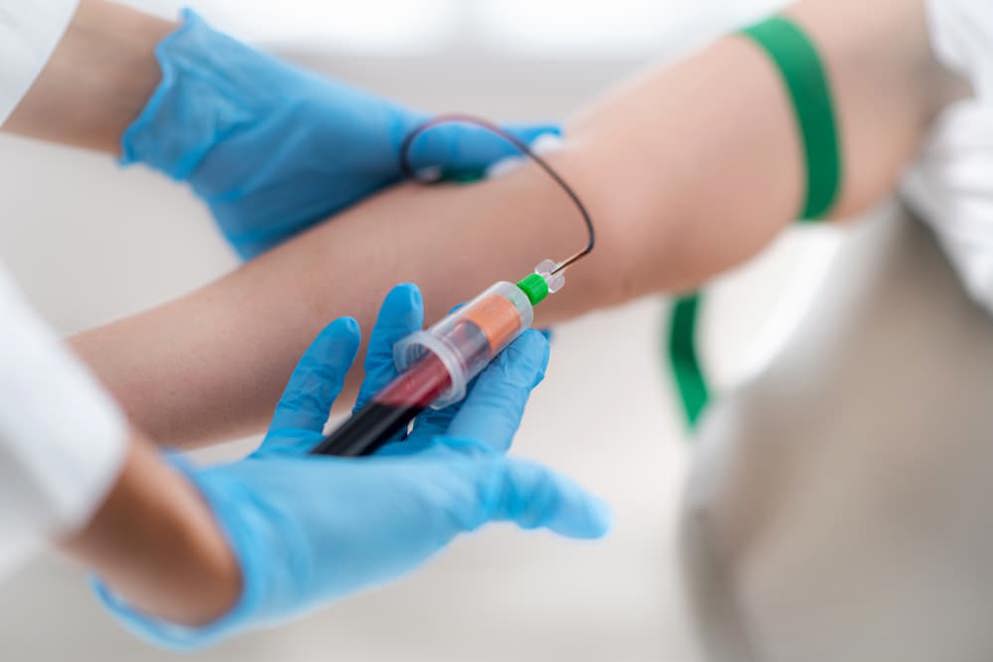
Test your knowledge
Meet Amelie
Amelie is a 42-year-old woman with T2D, HT, gout, and osteoarthritis. She has previously been prescribed metformin, a fixed dose combination of lisinopril and hydrochlorothiazide*, and naproxen†. She is a new patient and has come in to meet you for a health checkup. In the following questions, please select all answers that apply.
Learn more about early diagnosis and screening
Looking at Amelie’s medical history, you can see that she has had a stable serum creatinine of 0.9 mg/dl and an eGFR 51ml/min/1.72m2 over the past 6 months.
Learn more about the treatment and management of CKD and comorbid conditions
Now you have screened and diagnosed our virtual patient Amelie. Continue on to our treating chronic kidney disease section to find our second virtual patient Thomas who has progressive CKD.
Abbreviations
ACE, angiotensin converting enzyme; CKD, chronic kidney disease; COX, cyclooxygenase; eGFR, estimated glomerular filtration rate; HT, hypertension; KDIGO, Kidney Disease: Improving Global Outcomes; NSAID, non-steroidal anti-inflammatory drug; T2D, type 2 diabetes mellitus; WHO, World Health Organisation. Amelie is a theoretical patient case adapted from existing case studies for educational purposes only9,10. *The fixed dose combination product of lisinopril, an inhibitor of ACE, and hydrochlorothiazide, a thiazide diuretic, are indicated for primary hypertension11; †Naproxen is a non-selective COX inhibitor and NSAID indicated for the treatment of osteoarthritis and acute gout12.
Meet Thomas
Thomas has come in for his routine health check-up. He is a 61-year-old man with CKD as well as a long history of HT and smoking. His eGFR is 39 mL/min/1.73m2 and has been stable over the past year. However, despite successful control of his HT with ACE inhibitors (average blood pressure < 120/70 mmHg), his urine ACR remains elevated at 301 mg/g.
Learn more about the management of ESRD, guidelines, and future treatments
Following the administration of dapagliflozin, Thomas is no longer showing signs of CKD progression and his blood pressure remains well controlled. However, if Thomas’ CKD were to progress, challenges could arise in the management of his disease.
Abbreviations
ACE, angiotensin-converting enzyme; ACR, albumin-to-creatinine ratio; CKD, chronic kidney disease; CREDENCE, Canagliflozin and Renal Events in Diabetes with Established Nephropathy Clinical Evaluation; CVD, cardiovascular disease; DAPA-CKD, Dapagliflozin and Prevention of Adverse Outcomes in Chronic Kidney Disease (DAPA-CKD); DPP4, dipeptidyl-peptidase 4 inhibitors; eGFR, estimated glomerular filtration rate; EMA, European Medicines Agency; ESRD, end-stage renal disease; FDA, Federal Drug Administration; GLP-1 RA, glucagon-like peptide-1 receptor antagonists; HT, hypertension; KDIGO, Kidney Disease: Improving Global Outcomes; RASi, renin-angiotensin system inhibitors; SGLT2i, sodium/glucose cotransporter-2 inhibitors; T2D, type 2 diabetes mellitus. Thomas is a theoretical patient case adapted from existing case studies for educational purposes only9,10.
Chronic kidney disease is often underdiagnosed and treated too late, but how much do you know about the latest guideline advice in chronic kidney disease? Your responses will help us to create content that is most relevant to your clinical practice. Thank you.
Please share with us your understanding of CKD BEFORE you encountered the Chronic Kidney Disease Learning Zone on Medthority.com.
AFTER you have explored the Chronic Kidney Disease Learning Zone on Medthority.com, please share with us what you now understand about CKD diagnosis and management. Thank you.
References
- Braun L, Sood V, Hogue S, Lieberman B, Copley-Merriman C. High burden and unmet patient needs in chronic kidney disease. International Journal of Nephrology and Renovascular Disease. 2012;5:151.
- Hill NR, Fatoba ST, Oke JL, Hirst JA, O’Callaghan CA, Lasserson DS, et al. Global prevalence of chronic kidney disease - A systematic review and meta-analysis. PLoS ONE. 2016;11(7):e0158765.
- Kidney Disease: Improving Global Outcomes (KDIGO) Diabetes Work Group. KDIGO 2012 Clinical Practice Guideline for the Evaluation and Management of Chronic Kidney Disease. Kidney Int Suppl. 2020;98(4S):S1–S115.
- Kidney Disease: Improving Global Outcomes (KDIGO) Blood Pressure Work Group. KDIGO 2021 Clinical Practice Guideline for the Management of Blood Pressure in Chronic Kidney Disease. Kidney international. 2021;99(3S):S1–S87.
- Kidney Disease: Improving Global Outcomes (KDIGO) Diabetes Work Group. KDIGO 2020 Clinical Practice Guideline for Diabetes Management in Chronic Kidney Disease. Kidney International. 2020;98(4A):S1–S115.
- Shlipak MG, Tummalapalli SL, Boulware LE, Grams ME, Ix JH, Jha V, et al. The case for early identification and intervention of chronic kidney disease: conclusions from a Kidney Disease: Improving Global Outcomes (KDIGO) Controversies Conference. Kidney International. 2021;99(1):34–47.
- Kidney Disease: Improving Global Outcomes (KDIGO) CKD Work Group. KDIGO 2012 clinical practice guideline for the evaluation and management of chronic kidney disease. Kidney Int Suppl. 2013;3(1):1–150.
- Romagnani P, Remuzzi G, Glassock R, Levin A, Jager KJ, Tonelli M, et al. Chronic kidney disease. Nature Reviews Disease Primers. 2017;3.
- Poudyal M. Chronic Kidney Disease for the Primary Care Physician. American College of Physicians. 2020. https://www.acponline.org/system/files/documents/about_acp/chapters/co/20mtg/poudyal.pdf. Accessed 7 September 2021.
- Frroku-dido S, Nigro SC. Interactive case studies. Pharmacy Times. 2021. https://www.pharmacytimes.com/view/interactives-case-studies-march-2021. Accessed 13 September 2021.
- Electronic Medicines Compendium (EMC). Zestoretic 10 - Summary of Product Characteristics (SmPC). 2020. https://www.medicines.org.uk/emc/product/5501/smpc. Accessed 8 September 2021.
- Electronic Medicines Compendium (EMC). Naproxen - Summary of Product Characteristics (SmPC). 2019. https://www.medicines.org.uk/emc/product/5823/smpc. Accessed 8 September 2021.
- Perkovic V, Jardine MJ, Neal B, Bompoint S, Heerspink HJL, Charytan DM, et al. Canagliflozin and Renal Outcomes in Type 2 Diabetes and Nephropathy. New England Journal of Medicine. 2019;380(24):2295–2306.
- Heerspink HJL, Stefánsson B V., Correa-Rotter R, Chertow GM, Greene T, Hou F-F, et al. Dapagliflozin in Patients with Chronic Kidney Disease. New England Journal of Medicine. 2020;383(15):1436–1446.
- United Stated Federal Drug Administration (USFDA). FARXIGA Highlights of prescribing information. https://www.accessdata.fda.gov/drugsatfda_docs/label/2020/202293s020lbl.pdf. Accessed 7 September 2021.
- European Medicines Agency (EMA). Forxiga Summary of Product Characteristics (SmPC). https://www.ema.europa.eu/en/documents/product-information/forxiga-epar-product-information_en.pdf. Accessed 7 September 2021.
- Thomas B, Matsushita K, Abate KH, Al-Aly Z, Ärnlöv J, Asayama K, et al. Global cardiovascular and renal outcomes of reduced GFR. Journal of the American Society of Nephrology. 2017;28(7):2167–2179.
- Sumida K, Kovesdy CP. Disease Trajectories Before ESRD: Implications for Clinical Management. Seminars in Nephrology. 2017;37(2):132–143.
- Yamazaki T, Mimura I, Tanaka T, Nangaku M. Treatment of diabetic kidney disease: Current and future. Diabetes and Metabolism Journal. 2021;45(1):11–26.
- Chang P, Gill J, Dong J, Rose C, Yan H, Landsberg D, et al. Living donor age and kidney allograft half-life: Implications for living donor paired exchange programs. Clinical Journal of the American Society of Nephrology. 2012;7(5):835–841.
of interest
are looking at
saved
next event




